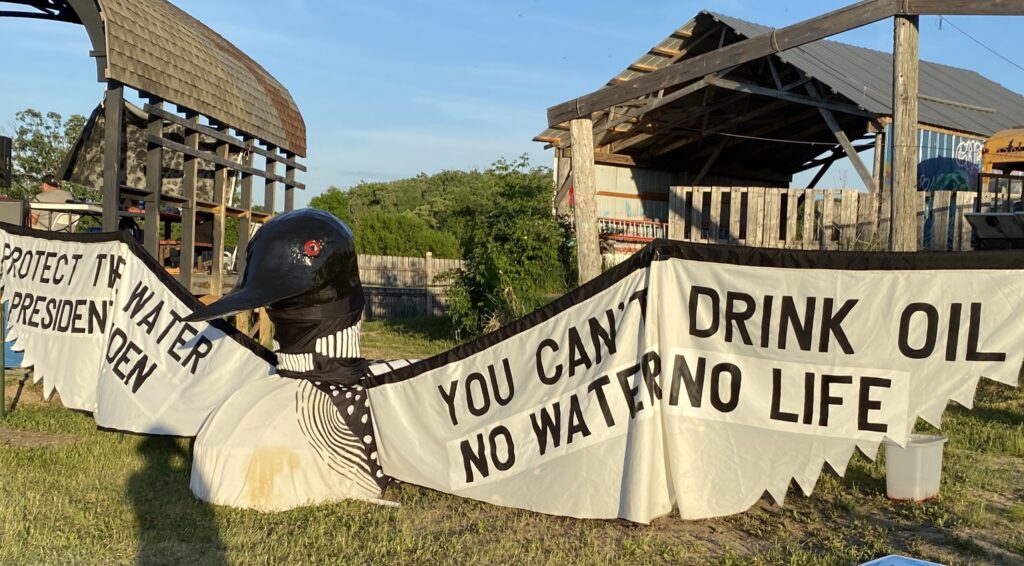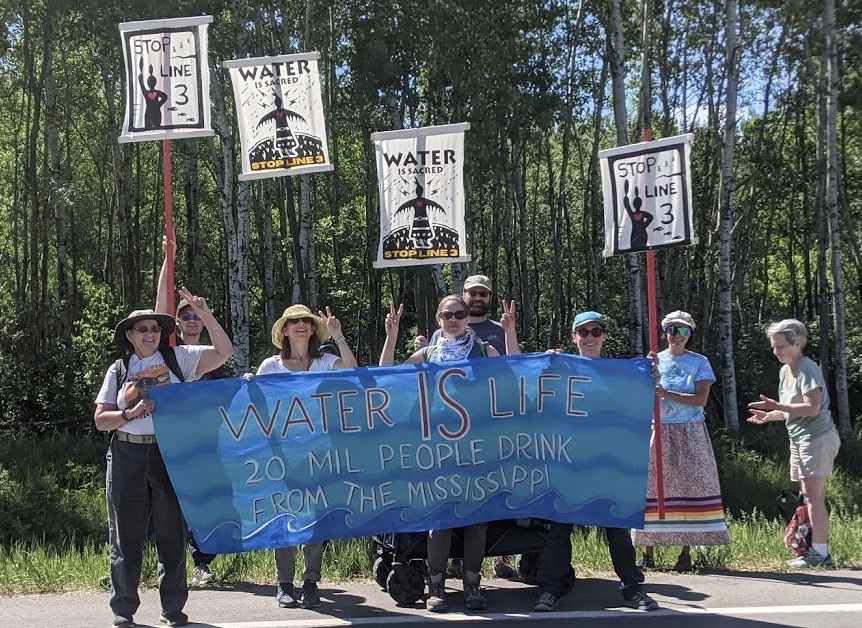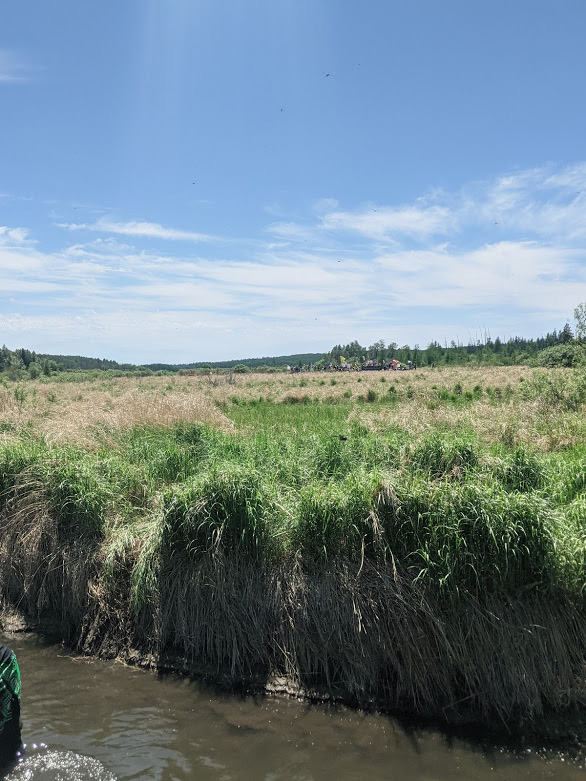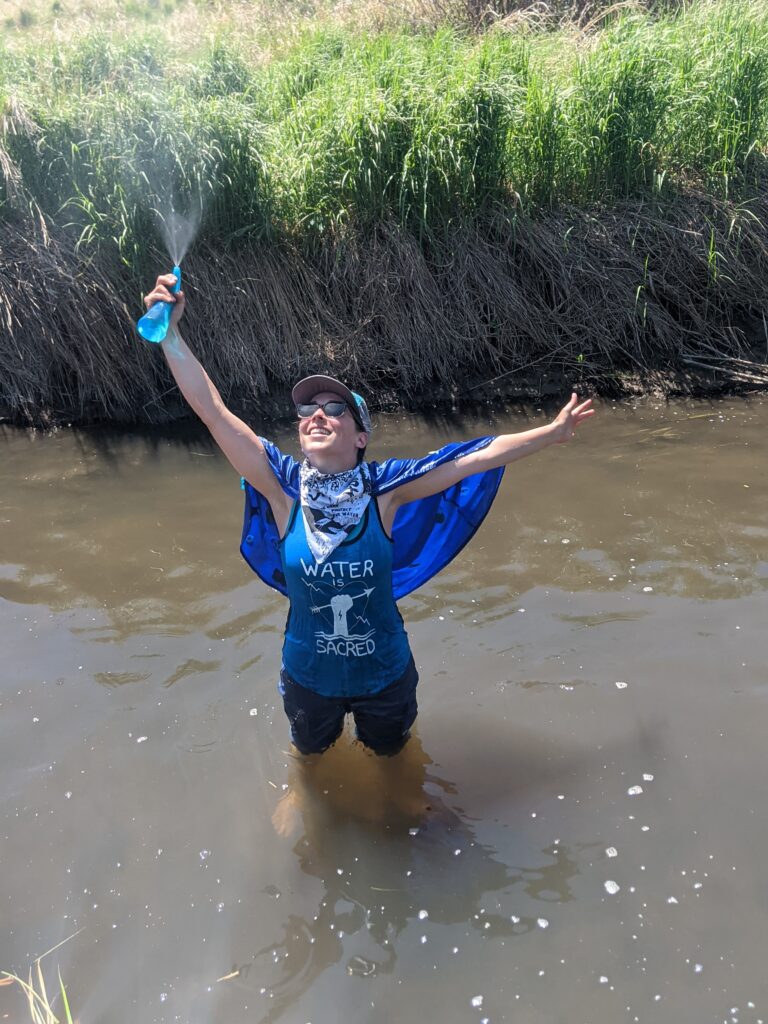
Putting it all on the line to protect the sacred water
June 27, 2021
By Jane Goldenberg
When I arrived at Pure Bliss Ranch on the White Earth Reservation in northern Minnesota for the Treaty People Gathering in early June, I immediately felt a shared sense of our righteous cause, and the anxiety I felt about coming alone melted away.
My Climate Reality friend Jennifer Linton, with whom I had traveled from Chicago, had been sent to another site. I carried the signs she made to help connect the Illinoisans, who had met via secure SMS in the months leading up to this long-anticipated weekend.
Volunteer greeters ushered me through the gates, pointed out the volunteer sign-up table, provided a map with guidelines and a schedule printed on newsprint. I was reminded to take no photos unless I had the express permission of everybody in the shot.
We had come to stop Enbridge, a Canadian multinational company, from continuing work on the Line 3 tar sands pipeline—which would double its capacity to 760,000 barrels of oil a day—through tribal territory and to protect the sacred water and wild rice beds. The local Indigenous people, tribes of the Ojibwe nation, had issued an invitation for people to join the protest, and we had answered the call. The pipeline expansion project runs through the territory of several reservations, including White Earth, Leech Lake and Fond du Lac, and ends by Lake Superior at Superior, Wis.
The sanctity of our purpose was top of mind as a large diverse group gathered to listen to the welcome program and prayer. Around 1,000 activists were scattered in the grass and seated on white folding chairs under two massive canopy tents on these lovely, rustic festival grounds by the White Earth River. Many attendees had set up tents on site. The scorching 98-degree weather, 20 degrees above normal, underlined the critical nature of the climate crisis we faced.
Over the next couple of days, we received an intensive training from tribal elders into the ways of the Anishinaabe people and their sacred relationship with Mother Earth, which they refer to as Nimaamaa-aki. The purpose of our three-day mission, June 5–8, was crystalized by Winona LaDuke, executive director of Honor the Earth, speaking to us from an open-air stage on our first afternoon.
“The water belongs to the people. The water belongs to the fish,” she said. “It doesn’t belong to Enbridge…. It’s time to be here for the water, Minnesota.”
“We love our non-native allies!” called out Nancy Beaulieu (pronounced BOW-li-o), northern Minnesota organizer for MN350 and a founder of the RISE — Resilient Indigenous Sisters Engaging — Coalition. “We’re all treaty people. We all have an obligation to uphold those treaties,” she added, referring to a series of three treaties that established the tribes’ right to hunt, fish and gather across their ancestral homeland.

“My responsibility is to take care of Nimaamaa-aki,” she explained, using the Ojibwe word for Mother Earth.
Our hearty applause acknowledged the necessity of the political capital we carried in our diversity: people of all ages, from couples with babies to folks in their 80s, who came from all over the country, as far away as Hawaii and Puerto Rico (as attendees announced from the crowd). Some walked with canes. Tribal members traveled from Washington, Montana, Arizona and North Carolina, among other places, to join the protest.
By early evening, with the sun still bright in the sky, my large Illinois sign had attracted five more Illinois protestors, most of whom were camping on site. Over the course of the weekend, I would see the telltale Illinois banners Jennifer had screenprinted pinned to people’s pants, packs and shirts.
We had a large, proud contingent eager to learn from our Indigenous hosts their traditional wisdom about how water is sacred and all life is interconnected. We learned the prophecy of the ma’iingan (the wolf), which is what happens to the Anishinaabe will happen to the ma’iingan and vice versa, and we heard traditional drumming and native songs like “Fly Eagle Fly” from Vancouver Island, as well as music from Ojibwe rapper Thomas X.
Later we split into groups to practice songs we would sing at Monday’s protest, including, “The Nibi Song” by Dorene Day and her grandson, whose lyrics translate as: “Water, we love you/We thank you/We respect you.”
The Indigenous speakers understand well the power of music.
“Our songs that come through this drum are powerful, prayerful, come from deep in our hearts,” explained Raymond Kingfisher, of the Northern Cheyenne tribe of Montana and a founder of the Protectors of the Salish Sea. “We thank you for being witnesses to this. The drum (is) known as the heartbeat of our nations.”
A duty to protect
I felt grateful for their commitment, which they consider their ancestral duty to protect the resources that sustain us, and I wished our own culture could understand these essential connections.
Drawing on centuries of oral history, White Earth tribe member Dawn Goodwin told us: “It’s my duty to protect the environment and the lands, our relatives, the four-leggeds, the crawlers and the swimmers.” Goodwin, who led the program for much of that first afternoon, is one of four women who founded RISE Coalition.
Unlike in our Eurocentric culture, where, historically, our policy makers focused on conquering nature, Indigenous people reject the idea of hierarchy among the creatures who share Mother Earth.
“Man created the hierarchy for profit,” explained Great-Grandmother Mary Lyons of the Leech Lake Band of Ojibwe, who stood alongside a daughter, two granddaughters and a great granddaughter, all in traditional colorful skirts.
Like water, which flows every which way, what impacts one part of our ecosystem ripples throughout. You can’t localize the damage of a leaking pipeline. And all water is one.
If that doesn’t scare you, you’re not paying attention, especially when you consider how many oil and gas pipelines crisscross our country — 2.5 million miles worth — and that hundreds of accidents occur every year.
But tar sands oil is the worst. The heavy, sludgy crude sinks in water and is, therefore, nearly impossible to fully clean up. The new Line 3 would touch some of the greatest fresh water in the world, including the Mississippi and the Great Lakes. The line would run through 22 rivers, 200 bodies of water and 800 wetlands, Tara Houska, a tribal attorney, who started the Giniw Collective, said on one of the regular Facebook postings from the field.
Treaty law and other legal tactics
As the fossil fuel industry scrambles to hang on to its fading business, these Indigenous leaders, alongside their relatives from around the country hope to use their treaty rights — “The Supreme law of the land, as stated in Article VI of the U.S. Constitution”— to save our ecosystems from the damage crude oil can wreak.
“Never once did we surrender our inherent right to hunt, fish and travel,” Beaulieu said.
“What good are treaty rights if we don’t stand by them,” she added. “We ask you guys to be our voice, our protection and stand with good hearts on Monday…. Miigwech,” which means thank you in the Ojibwe language.
The 1974 landmark Boldt Decision affirmed the Indigenous treaty rights in the state of Washington. While the tribes of Washington had ceded their right to the land, they had reserved the right to fish as they had always done at their traditional locations that were off the reservation.
The decision has helped the tribes take down dams that posed a threat to salmon populations. This is the same right the Ojibwe tribes are asserting in Minnesota. What good is the right to fish, hunt and gather wild rice if the water is ruined by tar sands oil?
On another legal front, environmentalists and Indigenous leaders are hoping to force regulators to consider demand when making decisions on whether to approve new pipelines. In short, do we even need more oil? The Biden Administration has proposed making such a change to the Federal Energy Regulatory Commission, but it could take years for that process to play out.
Our free market already shows the fossil fuel business is in decline. Even the Saudi Sovereign wealth fund divested from their tar sands investments earlier this spring. An increasing number of major financial institutions — 77 at last count — have pledged to stop funding or insuring the tar sands industry.
With renewable energy now cost competitive and the impacts of the climate crisis worsening each year, all of us at the tribal gathering believe construction on Line 3, as well as any new pipeline expansion projects, must come to a halt.
Over the past seven years that the tribal leaders have been fighting Line 3, the courts have mainly rejected their arguments. But now, with Enbridge promising to finish the pipeline project this year, they and environmental groups are asking President Biden to cancel the project. Two other cases challenge the projects permits, issued by the U.S. Army Corps of Engineers, under the Clean Air Act. If Keystone XL cannot stand, how can Line 3, which would carry the same amount of tar sands oil?
If Minnesotans are so proud of their 10,000 lakes, why are they OK with tar sands oil running through their bounteous supply of fresh water? Anyone who’s ever lived in a house or near any of the thousands of pipelines that cut across our country knows very well that pipes and pipelines regularly spring leaks. How could so many Americans take our precious natural resources for granted?
Training Day
Sunday was devoted to training for the big event on Monday and to convince as many of us as possible to volunteer for “red roles,” which meant to participate in actions that could lead to arrest. The more we understood the stakes, the more impassioned we became, and, with every fresh ask to volunteer for a red role, more hands flew up.
While I felt fully committed to the task at hand, I stuck to my green role (no to low chance of arrest). I also volunteered for clean-up duty following the breakfast meal service on Sunday. The organizers provided good, hearty meals, some of which included Manoomin, their sacred wild rice, dependent on the water we vowed to protect.
About 1,000 activists of all ages, from 20-somethings to folks well into old age, would head up to an Enbridge pumping station the next morning to take their positions in a direct action, which meant some would chain themselves to heavy equipment and, thereby, risk arrest.
I and my group of about another thousand people caravanned in a northwesterly direction on dusty dirt roads about an hour away for a march near the headwaters of the Mississippi River. I had never before seen land covered by so much water, lakes every half mile or so, surrounded by marshes and rivers, even in conditions of a severe spring drought. Everywhere we went, we were engulfed by swarms of dragonflies.
Our group had folks in all three roles, including yellow (a low but possible risk of arrest). For security reasons, our trainers told us nothing about what the other groups would be doing because infiltrators could be among us. We were told to find or create an “affinity group,” a small group of trusted people, stick together and use a Sharpie to write the jail support phone number on our bodies. Other directives: “Stay in your role!” “Don’t talk to the police.” “No drugs, no weapons, no phones, no notes from workshops, no walking sticks.” I supposed canes required for walking weren’t included.
Stand with us

On Monday morning after an opening prayer and the inspirational words of the powerful LaDuke and Beaulieu at Pure Bliss, we were ready to hit the road.
Armed with loads of water, insect repellent and sunscreen on a day that would again reach unseasonably hot temperatures, we marched, chanted and heard from actress Jane Fonda, Bill McKibben, co-founder of 350.org, and many others.
As the sun rose high in the sky, accompanied by the sound of prayerful drumming, we sang,
“The ancestors have spoken,
Now is the time,
Protect the sacred,
Shut down the pipeline.”
We bore witness as the folks in red roles walked down the temporary timber road constructed by Enbridge. As the protesters continued on, a heavy emotion rose into my throat, and I was struck dumb by the beauty of this place, the threat of tar sands oil to this precious water and the courage of the folks in red roles, snaking down toward the Mississippi. They carried a large American flag, flapping in the wind, as well as drums and signs that said: “Stop Construction” “Honor the Treaties” and “Protect Water,” among others. I composed myself and picked up the chant as the group waded into the tall grass toward the banks of the murky, shallow baby Mississippi.
We held the road and the bridge for several more hours until we were informed of our victory. Enbridge had shut down for the day. Clearly this was mainly a result of the protesters who put their bodies in the way of any continued construction at an Enbridge pumping station. Our large presence across multiple sites had helped to overwhelm the authorities.
Arrests and encampment
By the wee hours of the next morning almost 200 people — including Jennifer and two others from our Chicago chapter — had been arrested at Enbridge Two Inlets Pumping Station and transported to eight county jails scattered across Minnesota. But not before they faced a low-flying U.S. Customs and Border Protection Agency helicopter that sent up waves of dust, billowing in their faces.
How horribly ironic that border control would basically “assault Indigenous people in their own homeland,” LaDuke later told Democracy Now.
“We are from this place. We’ve been from this place since before the United States, Canada and all if it began,” Houska observed. “The only threat here is Enbridge to this beautiful place.”
The police, which has received at least $750,000 from Enbridge to protect the pipeline project, also subjected protestors to a long-range acoustical device, LRAD, which can cause hearing loss.
The encampment — Firelight Camp — at the Mississippi Headwaters where we marched, continued for the next eight days until the protestors voluntarily left on June 15, but not before police delivered many citations and made other arrests.
The protests continue because this is a battle for the future, and we’re in it for the long haul.
If you ever have the opportunity to stand alongside these Indigenous women leaders to protect our sacred water, land and ecosystems, run don’t walk. You’ll never be the same. Miigwech.
The call for water protectors continues
The destruction worsens by the day. Line 3 waterway crossings began in mid-June, and drilling now often continues through the night. Enbridge recently received additional permits from the Minnesota Department of Natural Resources to take an additional 4.47 billion gallons of water, nearly a 10-fold increase from what the company was originally granted. The purpose includes the “dewatering of the trench along the entire pipeline corridor and related pump station facilities,” according to a DNR statement. This increase is particularly problematic given the region’s historic spring drought.
To stay abreast of events at the ongoing protests at Line 3, accounts to follow on social media include: @HonorTheEarth @GiniwCollective @RISEandEngage @MN_350
The Indigenous leaders have issued a standing invitation to “Come to the Line.”
To get involved and take action before it’s too late, go to stopline3.org/hub.
Tell President Biden to Stop Line 3.
View a map of the water crossings.
See the spiritual aspects of the protest at Line 3 beautifully captured in this photo essay by Dave Parry, a photographer I met at Pure Bliss Ranch.
UPDATES
On June 14, the Minnesota Court of Appeals affirmed a Certificate of Need and Routing Permit granted by the Minnesota Public Utilities Commission, dealing the tribes a defeat. But all are dug in for a long fight. According to an article in Bloomberg, Enbridge asserts they’re on track for the new and expanded Line 3 pipeline to go into operation during the fourth quarter of this year.
The Biden Administration signaled in federal court on June 24 that it did not intend to cancel the permit for Line 3. The Army Corps of Engineers asked for the dismissal of the lawsuit by the the Red Lake Band of Chippewa Indians, the Sierra Club and others. Michael Brune, executive director of the Sierra Club, said in a statement: “Allowing Line 3 to move forward is, at best, inconsistent with the bold promises on climate and environmental justice President Biden campaigned and was elected on.”
SOURCES
• Police make mass arrests at protest against oil pipeline.
• Explaining Ojibwe treaties
• Pipeline accidents
• Boldt decision
• Washington State salmon habitat restoration
• Decades-long fight to take down the dams in Washington
• Saudi Sovereign Fund divests
• Border Protection rotor washing protesters
• Yale Climate Connections about divesting from tar sands oil
• Bill McKibben review of divestment

Jane Goldenberg attended the 2019 Minneapolis Climate Reality Leadership Corps training. She has worked as a journalist, teacher and communications consultant and is currently vice chair of communications for the Chicago Metro Chapter.





